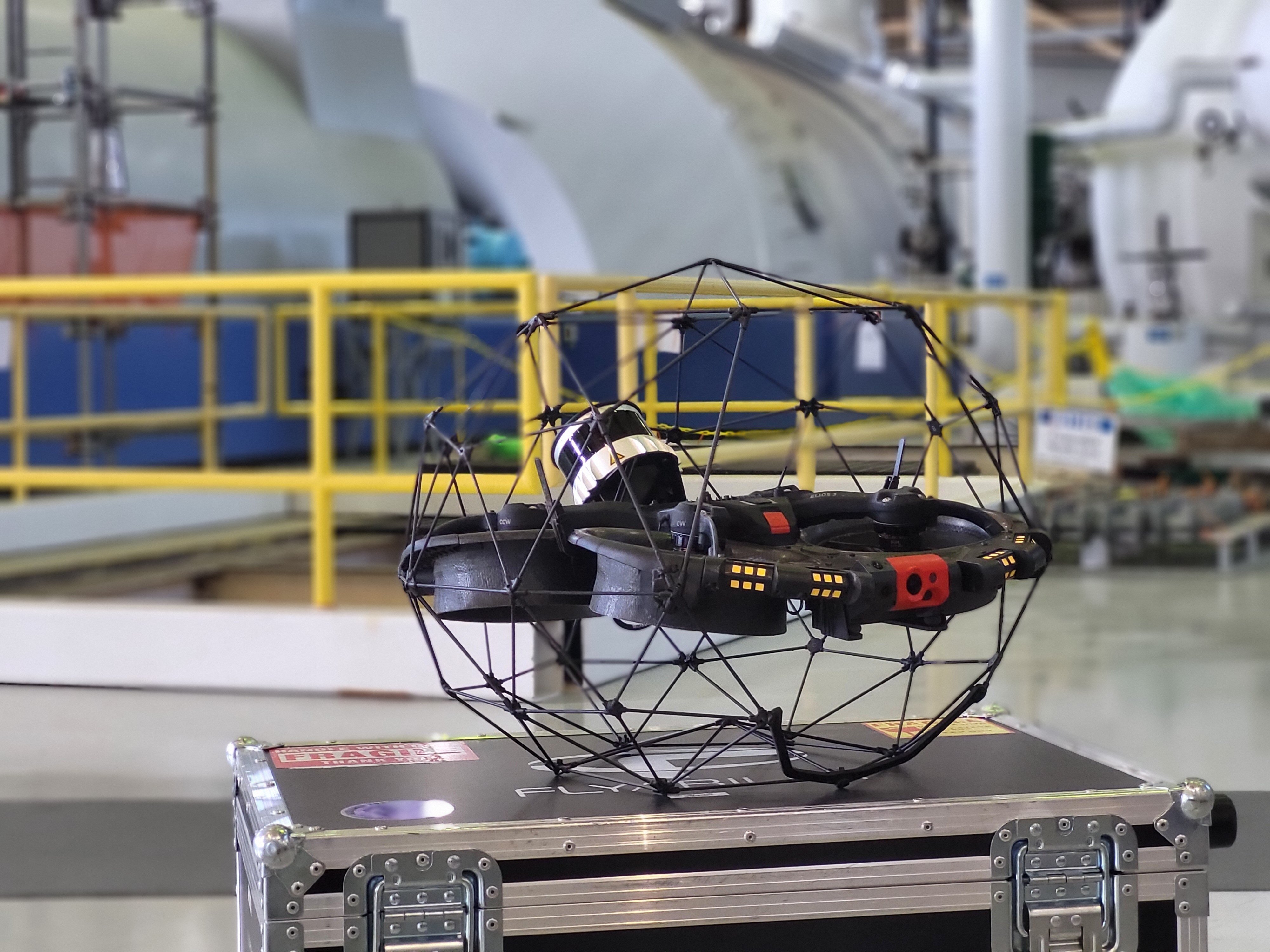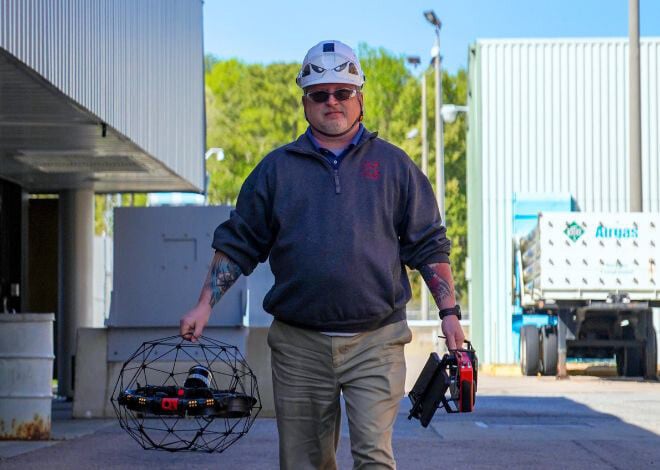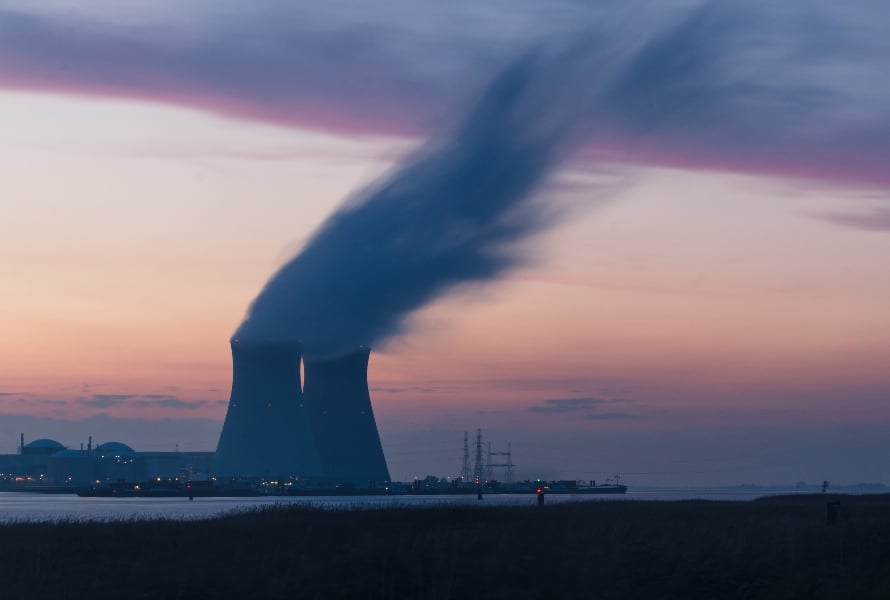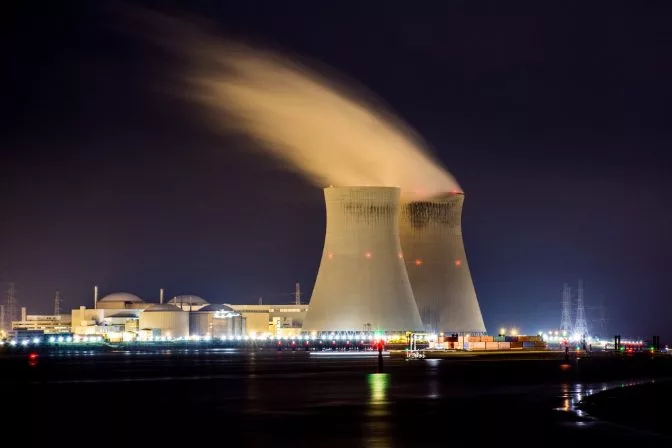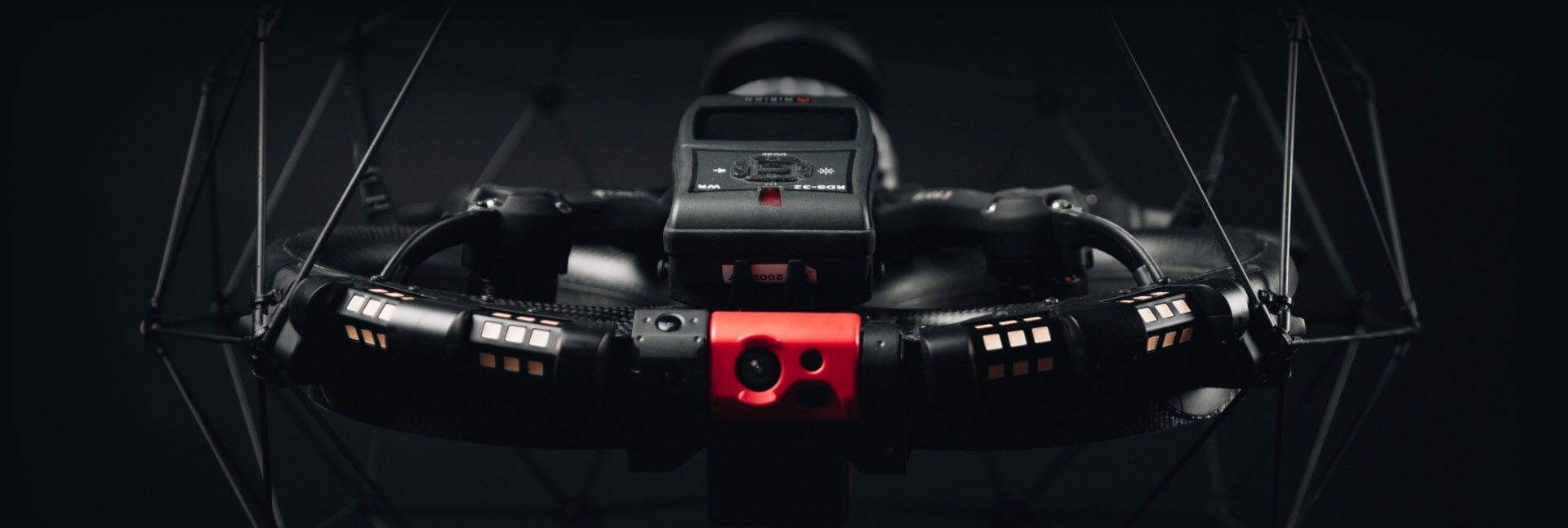- Blog >
- Lighting Up: The Benefits of Drones in Power Generation
Lighting Up: The Benefits of Drones in Power Generation
How are energy companies using drones in power generation? What problems can drones solve? Discover the benefits of drones in energy and see real-world case studies in our blog on this topic!
If you’re reading this article, you’re involved with one of the biggest markets in the world: the energy sector. The Flyability website is accessed via phones, laptops, or tablets - all of which rely on electricity we get from power generation sites. This immense industry is under increasing pressure to meet our insatiable demand as humans use more energy to move, communicate, and learn.
How can the energy sector meet this demand? Diversifying energy generation techniques is one way, but optimizing existing systems by investing in new and innovative technology is another. New technology can offer exciting solutions to old problems, cutting downtime and maximizing energy production operations. One small tool is part of this modernization: the humble drone is one of the biggest gamechangers in power generation.
What are drones used for in the energy sector?
Drones aren’t going to be used to generate power themselves, but they can be an incredibly useful method of inspecting and managing energy infrastructure. By streamlining inspections, drones offer energy providers more efficient facility management. Drones can do this because they are typically small, maneuverable devices that can be equipped with various payloads and sensors to gather critical data in inaccessible or dangerous spaces.
Drones offer visual inspections, ultrasonic thickness measurements, and 3D modeling capabilities, among other capabilities that enhance facility inspections! This makes asset management easier as you can get clear, accurate information about the condition of an asset, whether it’s a boiler or wind turbine. You can then use that information to plan maintenance work without prolonging downtime. The ideal thing about drones is that they can be deployed quickly. For example, if you wish to inspect a cooling tower, you likely have to erect scaffolding or use cherry pickers and face several days of downtime. A drone can do the inspection in hours, if not minutes, with 0 scaffolding involved, drastically reducing the time the asset is out of action and boosting operational efficiency.

LiDAR scans of a penstock captured with the Elios 3 drone. Using a drone for penstock inspections cut inspection times by 80%!
Thanks to the flexibility of drone technology, they can be easily integrated with existing inspection schedules and complement current processes. Whether it's helping eliminate unnecessary work at height on scaffolding or gathering data in a dangerous environment, such as inside contaminated areas of a nuclear power plant, drones can help answer questions about the asset’s status without putting people in danger or compromising the quality of results.
Besides the clear benefits of power generation drones related to safety, speed of facility inspection, and accuracy of results is the fact that this is a tried and tested technology. Drones are not new - there are dozens of ways to use drones for power generation inspections. The drone market in the energy sector alone is estimated to be valued at 4.4 billion USD by 2030.
The challenges of power generation inspections and how drones solve them
Power generation is an umbrella term for an incredibly varied industry. This term encompasses facilities that include dams that are hundreds of meters tall, wind turbines, thermal power plants, and nuclear reactors. The huge infrastructure of this industry powers millions of homes, businesses, and factories, putting it under intense pressure. Managing these facilities is a mammoth task - even small unexpected failures or disruptions can impact hundreds of thousands of people.
The typical dangers of inspections in power generation assets include exposure to heat, work at height, and entering confined spaces. In fact, 20% of all injuries at thermal power plants in the USA are caused by work at height, either through falls or dropped-material injuries.

Stack inspections typically require scaffolding and ropers - but drones require neither, keeping teams safely on the ground.
Some of these dangers occur due to the nature of the assets being inspected: to inspect a boiler, people have to enter the structure, climb tens of meters of scaffolding, and then gather visual and ultrasonic thickness measurements (UTM) inside of it. To inspect a stack, you need to hire scaffolding or use a cherry picker to give an inspector access to the stack structure. Alternatively, rope access is sometimes an option or necessary - and some stacks are just impossible to safely inspect with people due to the height, confined space, and hazard risks. Eliminating these dangers through drone inspections has two advantages: firstly, it keeps staff safe, and secondly, it often reduces the overall inspection time. Human risk exposure requires careful assessments and additional safety protocols - these aren’t as stringent if you’re sending a drone instead of a person into a hazard zone.
Drones can be deployed for power generation inspections as they provide easy, safe access to difficult environments, from confined spaces to radioactive contamination areas. The inspector can pilot the drone, and in the case of a UAV like the Elios 3, they can simultaneously gather visual data and UTM, giving them complete data of their asset with 0 risk exposure. This is why drones are becoming the ideal solution to the challenges of power generation inspections.
Key benefits of drones in power generation inspections
Let’s break down the key advantages that drones offer power generation inspections:
- Safety:
When you deploy drones for challenging inspections, you reduce the risks that inspectors have to take. This can include entering confined spaces, working at height, or, in the case of nuclear power plants, unnecessary radiation exposure. Keeping inspectors safe makes it easier for the plant to operate as normal while ensuring the quality of work and life for inspectors. It also reduces the amount of safety protocols and assessments required, as drones do not require the same vigorous pre-inspection checks as people. Drones are thus an ideal tool for improving safety in power generation inspections. - Access:
Some assets are difficult to inspect due to their structure and layout. For example, in a wind turbine inspection, an inspector must climb into the turbine hub and then walk along the blade to visually assess the blade. The tapered shape and carbonfibre structure make this incredibly challenging for inspectors and there are extreme risks involved with this type of inspection - and humans can’t even access the entire space. Alternatively, drones like the Elios 3 can reach 80% of the structure, gathering 4K videos and centimeter-accurate LiDAR. No human entry of the blade is required and yet all of the necessary data is collected. That is the power of drone inspections - all the reward with none of the risks. Inspections are made possible by drones providing easy access to confined spaces, and there are additional benefits related to speed and safety too.
- Cost Efficiency:
The return on investment of using drones is one of the clearest arguments in favour of drone inspections in the energy sector. In an industry where downtime translates to lost revenue, faster inspections are the key to optimizing operations and reducing costs. For example, one waste-to-energy plant shortened their plant shutdown by 2 days thanks to using the Elios 3, saving over 250,000 USD. In another case, a wind farm saved over $500,00 by using the Elios 3 to internally inspect the blades of 100 wind turbines. They also reduced overall inspection times by 75%! The combination of easier access with faster inspections and improved safety standards results in cheaper inspections without a loss of inspection quality. Power generation inspection drones are the change makers of industrial inspections!
- Data Quality
The quality of results depends on the drone used for the inspection. Highly specialized inspection drones, such as the Elios 3, can offer incredibly detailed results. The Elios 3 can simultaneously capture 4K videos (12MP photos), centimeter-accurate LiDAR scans, and ultrasonic thickness measurements during an inspection. This means that if you’re flying the drone inside a boiler and want to take a UT measurement, the drone will make the thickness measurement and localize it within a 3D scan of the entire asset. Through this, you can assess the deterioration rate or changes to your asset over time and see the exact location of each measurement. This eliminates the need for repeat inspections and gives you a clear record of your asset’s condition, which you can compare to your next inspection with the drone. The Elios 3 makes it simple to get clear, accurate data. Easy to use and fly, the drone requires little training for inspectors, making it easy to integrate with existing inspection workflows and deploy for multiple applications. When it comes to drones in energy, the Elios 3 is leading the pack.
- Repeatable Inspections
Drones in energy inspections would offer little value if they were not a reliable tool. Through inspections with power generation drones like the Elios 3, you can replicate inspections over time. This means you can consistently get valuable and high-quality data while still ensuring the safety improvements and cost reductions you got the first time you used a drone.
The benefits are clear - power generation drones as an inspection tool as a long-term solution, providing safety improvements, quality data, and cutting costs. Let’s check out some case studies of real-world examples of drones in energy.

A boiler inspection with the Elios 3 includes a LiDAR scan (left) and ultrasonic thickness measurements
Case Studies: How are drones being used in power generation?
Let’s get to the numbers - what impact do drones have in energy facility inspections? How can they improve the process? Here are some case studies from across the power generation industry to show you the value of drone inspections.
- Dominion Energy uses the Elios 3 to inspect the internal elements of condensers during shutdowns at a nuclear power plant. Using the Elios 3 cuts confined space entry and unnecessary scaffolding work, keeping people safely on the ground instead of inspecting equipment at heights of 20 meters (65 feet). In the past, these inspections required 7 days of 12-hour shifts by staff - now the Elios 3 can complete the work in just 2 12-hour shifts. The Elios 3 doesn’t just save them time - it also cuts $150,000 in costs. Find out how.

The Elios 3 flying in a turbine deck at a nuclear power plant owned by Dominion Energy
- (Czech Republic) VZU Plzen Achieves 80% Reduction in Penstock Inspection Time
- Penstocks are the huge piping systems that transfer water from a reservoir behind the dam to the turbine house. They are at the core of hydropower generation. Inspecting them typically requires work at height, rope access, and even custom scaffolding rigs. VZU Plzen decided to use the Elios 3 instead, and managed to reduce the inspection time by 80%! They finished work in just 2 days instead of 12 - find out how they did it.
- (Hong Kong) Power Station Inspections by CLP Power Hong Kong Limited with the Elios 3
- CLP Power supplies 80% of Hong Kong’s population with electricity. As part of how they ensure smooth operations, they have been using Elios drones as a power generation inspection tool. They purchased an Elios 3 in 2022 and have been using it ever since to inspect power generation assets as well as general infrastructure at their power plants. These include boilers, indoor storehouses, pump pits, and general site inspections. Discover how they use their power generation drone!
These are just 3 examples of how drones in energy can elevate safety standards and cut costs. If you’re interested in seeing more power generation drone case studies, check out our resources page!
What is the future of drones in energy?
Power generation drones such as the Elios 3 are a tried-and-tested tool. They are the solution to some of the challenges faced by energy providers who need to produce as much electricity as possible to face rising demand. With the increasing reliance on AI this is only going to grow as server farms demand more power to keep up with our questions.
Drones in energy are not sporadic cases but real systems. Dominion Energy has over 10 Elios drones in its wider fleet - a clear example of how developing a drone program optimizes inspection capabilities. The drone sector is also rapidly developing and with the addition of more and more payloads that drones can support, from UT gauges to flammable gas sensors, they are offering more applications to the sites that adopt them. The adoption of drones in power generation is well underway.
If you’re like to learn more about drones in power generation, make sure to watch our webinar on using the Elios 3 to inspect boilers, stacks, and more!
If you’re specifically interested in wind turbines, we have a standalone webinar on the topic - you can watch the recording on our website!


